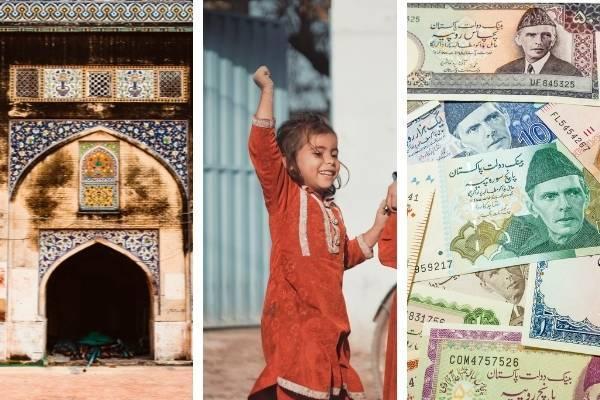
Are you thinking about sending money to Pakistan? If so, you may be wondering about the history of the currency of Pakistan. What are the currency denominations? How strong is it?
The evolution of Pakistan’s currency is an interesting topic including Pakistan's political and economic history. Over the last eighty years, there have been a lot of currency developments in Pakistan.
In this blog, we’ll explore the fascinating history of the Pakistani rupee, its exchange rates with some of the major currencies, and how you can send money to Pakistan.
- The currency of Pakistan
- How is the Pakistani rupee recognised?
- The history of the Pakistani rupee
- Exchange rates
- Pakistan’s economy
- How do I send money to Pakistan?
The currency of Pakistan
The currency of Pakistan is the Pakistani rupee. The currency has been vital for the country's economic growth in the latter half of the twentieth century and in particular in the last twenty years.
The currency is controlled and managed by the State Bank of Pakistan, the central financial institution in the country. The Pakistan currency name, the rupee, is the same as the name for the Indian currency. The word Rupee is derived from the ancient Sanskrit word “rup” or “rupa”, which means silver in many Indo-Aryan dialects. Now you know what the currency of Pakistan is, it’s time to dig a little deeper.
How is the Pakistani rupee recognised?
You might already know that the Pakistani rupee is recognised around the world by the code PKR. The sign for the Pakistani rupee is ₨. It is one of the major currencies in the region and is generally considered a stable global currency.
In fact, the Pakistani rupee “has emerged as the world’s best-performing currency as it appreciated the most against the US dollar” in the early months of 2021. So, let’s take a look at how the Pakistani rupee has developed to become what it is today.
The history of the Pakistani rupee
The Pakistani rupee originated in 1947 when Pakistan gained independence from the British Empire. The newly independent nation of Pakistan did not have the infrastructure in place to immediately establish a central banking system. That is why in the first year of Pakistan’s independence, Pakistan used the British Indian Rupee which was stamped with the words ‘Government of Pakistan’.
As the banking system emerged and the printing press was established, the new Pakistani rupee notes went into circulation. Denominations of 1, 2, 5, 10 and 100 rupee notes were released into circulation on the 1st of April 1948.
In the following years, the currency underwent some changes. Originally, the currency was divided into 16 annas, each of 4 pice or 12 pie. However, in 1961 the currency was decimalised. The currency remains in this state today. The Pakistani rupee is now subdivided into 100 pice or paise.
On the coins currently in circulation you can see illustrations of the Crescent and Star on one side. On the ₨.10 the reverse illustration is the Faisal Mosque in Islamabad and on the ₨.50 the reverse illustration is a side portrait of Abdul Sattar Edhii.
The depictions on the rupee notes are also quite interesting and highlight some of Pakistan’s stand-out national features. On the Green Rs.10 note, the depiction on the back is of the Bab-e-Khyber, the entrance of the famous Khyber Pass.
On the Rs. 50 note the depiction on the back is of K2, the second highest mountain in the world. On the dark green Rs. 500 you can see the Badshahi Masjid in Lahore. And on the yellow Rs. 5000 note you can see Faisal Masjid in Islamabad. Each depiction is a celebration of Pakistan’s history.
The complete history of Pakistan’s currency is quite complex. Let’s turn to exchange rates.
Exchange rates
In order to understand the worth of a currency on the global stage it helps to look at exchange rates. It is important to understand that exchange rates are constantly changing. However, by having a look at the average exchange rate over a year we can get a good idea of how well a currency is performing.
The Pakistani rupee has been relatively strong in recent years. Nowadays, the average exchange rate of the British Pound to the Pakistani Rupee was 217 PKR to 1 GBP.
It also helps to look at the Pakistan currency to the Dollar and to the Euro. As such, the average exchange rate of the Pakistani rupee to the US Dollar in 2020 was 1 USD to 161 PKR, with the rupee fluctuating slightly between the low 160s and high 150s.
Similarly, the exchange rate of the Pakistani rupee to the Euro on average throughout 2023 is 1 EUR to 316.30 PKR. These exchange rates with some of the major currencies show how the Pakistani economy has coped during the difficult times brought on by the pandemic.
Pakistan’s economy
The overall economic outlook of Pakistan has been positive in recent years. The economy has been growing slowly in the last two decades and there is a rising technological sector. However, in the last couple years the country has experienced an economic slump.
Agriculture was the largest sector at the time of independence and the introduction of the Pakistani rupee. Now the economy is far more diverse and there is a potential for a strong economy to emerge out of the chaos of the pandemic.
How do I send money to Pakistan?
If you have family, friends or business partners in Pakistan you may need to send money there, we can help.
Small World offers a range of payout options to cater to the needs of overseas Pakistanis/non-resident Pakistanis, enabling them to remit funds to their families for support. Our instant bank deposit service facilitates the transfer of PKR to any bank in Pakistan, including Habib Bank Limited (HBL), United Bank (UBL), Allied Bank, Meezan Bank, and other financial institutions.
Your first transfer online is always fee-free!